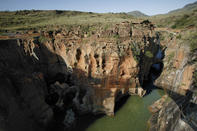The Blyde Canyon, also known as ‘Motlatse’, is the third deepest canyon in the world, with the Grand Canyon in the western U.S. and Namibia’s Fish Eagle Canyon as first and second, respectively. But its significance is in its breathtaking sights and astounding panoramic viewpoints, reaching 600m to 800m above the riverbed. The canyon is more then twenty kilometres in length.

Blyde Canyon stretches through the Drakensberg Mountain Range, which forms part of the seven main mountain systems in Africa. Its height and location provides for beautiful botanical vistas and Afromontane forests (Afromontane is a term used to describe the plant and animal species common to the mountains of Africa and the southern Arabian Peninsula). Walking trails laid out under the forest canopy enable close-up views of the terrain.
At the bottom of the Canyon there is a scarce and threatened Lowveld Riparian forest, only 100 hectares in extent. The River dams at the mouth of the canyon, forming the Blyde Dam at Swadini. The Blyde Dam provides for activities such as boat trips, viewing Tufa waterfalls, as well as canoeing, rock-climbing or abseiling. Hiking is another popular activity.
This region is host to many of the private game farms and lodges in the country. These establishments owe their existence and success to the fact that they are situated right on the border of Kruger Park, one of Africa’s best wildlife game reserves. Hoedspruit serves as the centre for the bushveld region, famed for its classic safari reserves. The area boasts some of the finest and most prestigious of these.
There are crafters, traditional dancers, storytellers, gardeners, singers and interesting water collection points throughout the villages, with many things to intrigue visitors. There are also traditional Shangaan and Nyani villages, where visitors can stay overnight at the rondavels that are similar to those used by the locals. Here one can experience the culture and traditional way of life of the people of this region. African beer, umqombothi is also served, along with African cuisine such as mopani worms (mainly in season) and other dish varieties.
The Masorini heritage site close to the Phalaborwa gate was once inhabited by a group of the Ba-Phalaborwa people, who made a living by manufacturing and selling iron artefacts during the Iron Age. The site has old shafts and stopes from which ore had been extracted in the early days. Local legend has it that the iron was beaten into assegai heads and primitive hoes and had been a form of currency among the Ba-Phalaborwa tribes. The trading of products made from the ore might have been a glimpse of the future of this region.
 Everyone loves a good road trip – and with a country as beautiful as South Africa, it’s easy to see why. Taking to the road is ingrained...
Everyone loves a good road trip – and with a country as beautiful as South Africa, it’s easy to see why. Taking to the road is ingrained...